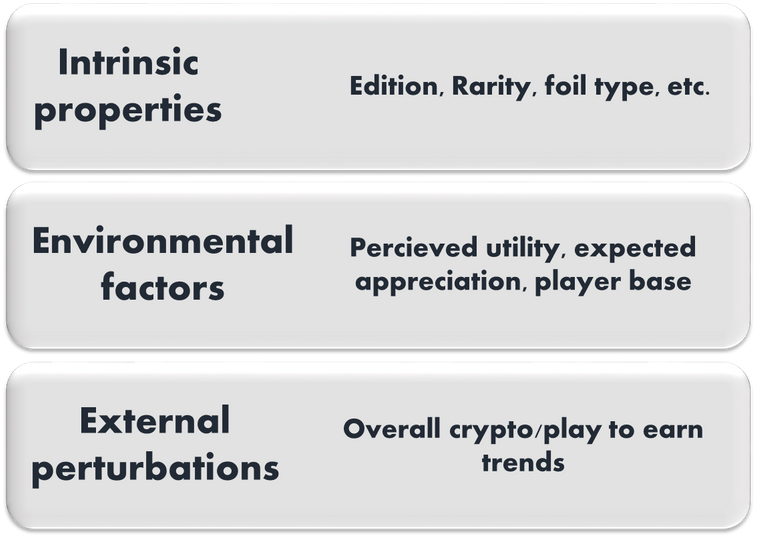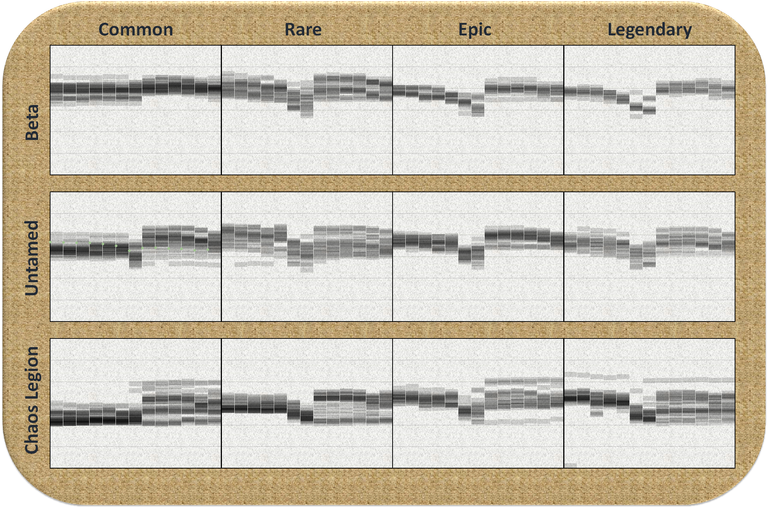Exploring Card market with PR index - Chapter 1
I introduced the PR metric in this post, please refer to it to fully understand what's going on here.
If you are already familiar with that, you will probably know that PR is strictly bounded to ROI.
Sure enough, PR value represents the days needed to repay a card investment only from renting revenue. For a number of reasons, I find that connection misleading, thus, I decided to mess it up a little bit, and, from now on I will refer to the PR index, which is nothing more than log(PR).
If you lack math fundamentals it won't be a problem, I did that exactly in order to detach PR from ROI and approach it agnostically as a simple index. Just remember, a PR index of 2 is insanely low and 5 is tremendously high.
In order to recap, my thesis is that PR value is driven by 3 different sets of forces:

Those 3 sets are characterized by distinct intensities over time: the intrinsic properties are not going to change from day to day, the environmental factors are mostly in the hands of the devs with meta changes and new releases, while the external perturbations are just storms.
If proven true and unveiled the magnitude of each force, we could use the PR index to preemptively identify price changes. But this is just a catchy argument to keep you up, while I dig deep into other cool things that we can already do with the PR.

I started to collect PR index values for all regular foil cards on Feb 9th, and to date, I collected one point every day until Feb 21st. We have 13 days recording with season-ending exactly in the middle of the data set.
The first chart I'm presenting is huge, 80 cm wide, or 30 inches for the empire citizens. Thus, I recommend looking at the original image.

This is a direct confrontation for all regular foil cards from each edition, in the middle of each section there is a green line that indicates season-ending. And, at the bottom in red, there is a Not for rent zone, in where there are cards not found in the rental market.
At a first look, the chart confirms the findings of the previous post, edition is a driving force for the PR. Though edition does not mean age, each one has its peculiar pattern: mini editions (Promo and Dice) are more dispersed, while proper editions (Beta and Untamed) are narrower. Reward edition is incredibly interesting due to the coexistence of cards in and out of the printing period, Chaos Legion struggles to find its place and Alpha is almost all in the not for rent zone (Probably Alpha cards owners are not extracting all the value they could from their assets).
Another piece of information that is possible to extrapolate from this chart is the length of the season-ending perturbation. The spike in the utility of the CP causes a dip in the PR chart, in order to analyze PR values for long-term use cases we should ignore this dip, which seems to extend for not more than 3 days.
The second chart inspects another intrinsic property, rarity. It confronts only regular foil monsters (no summoners) for the 3 proper editions: beta, untamed, and chaos legion.

Interestingly, I was wrong, it seems that rarity does not affect PR. At least not in the proper editions.
Nevertheless, an observation can be made to the different magnitude that the season-ending perturbation has over the common cards. Specifically, if we confront common beta and rare CL, they have 15 and 20 CP respectively, which is quite the same, but their reaction to the dip can't be more different. I'm not sure about the interpretation, but it might be that we are plenty of users that just skip commons while collecting CP, which means they are not using peakmonsters properly.
Another consideration could be mentioned. It seems to me, but more data are needed to confirm, that epic and legendary cards tend to be tighter around their average PR. This means that their behaviors are easier to predict than common and rare, thus, an investment in those cards should be more reliable over time. Not really sure about it, we will see it in the future.
This first chapter had been a descriptive analysis of some results, a proper discussion has to come. In the next chapters you can expect:
- Rarity among mini edition - is it worthless or not?
- Single card analysis - can math indicate bargains?
- Gold foils - why the heck are we ignoring them?
- PR and game tactics - can perceived utility suggest strats?
- and more has to come
In the meanwhile, why don't you have a look at this post from @bravetofu ? He applied a very close principle in order to find a great bargain
Electronic-terrorism, voice to skull and neuro monitoring on Hive and Steem. You can ignore this, but your going to wish you didnt soon. This is happening whether you believe it or not. https://ecency.com/fyrstikken/@fairandbalanced/i-am-the-only-motherfucker-on-the-internet-pointing-to-a-direct-source-for-voice-to-skull-electronic-terrorism